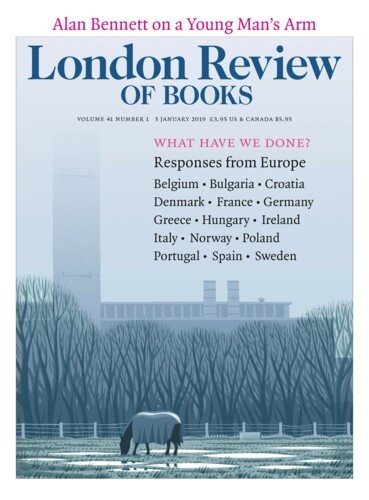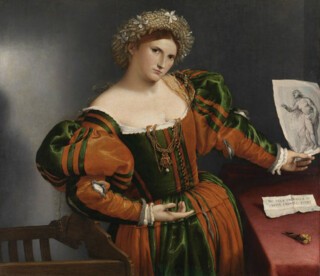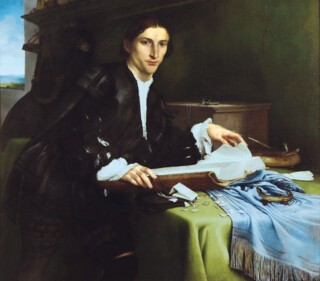For centuries the reputation of Venetian Renaissance painters largely depended on the comments made about them in Giorgio Vasari’s Lives of the Artists. Vasari was in Venice for several months in 1542, but he was evidently unaware that Lorenzo Lotto, a generation older than him, was also living there and that they had acquaintances in common. During his visit he made notes about a couple of paintings by Lotto in the city, but recorded nothing about his life, so the account that he provided in the first edition of his book, published in 1550, was only a paragraph long. In the second edition, of 1568, there is a little more about Lotto’s paintings in Venice and a new section about those in the area of Ancona, on the Adriatic coast. Against this background it is not surprising that Lotto, most of whose works were produced outside Venice, was almost entirely forgotten for the next three centuries. It was only when art historians began systematically to survey the surviving paintings of the Renaissance in Italy that he emerged, around 1900, as an outstanding artist with an easily recognisable style.
That style does much to explain why Lotto was much more successful in small provincial cities than in Venice itself, where the local artists tended increasingly to share the values of their contemporaries in Florence and Rome, with an emphasis on idealised settings and figures in eloquent and elegant poses often reminiscent of ancient art – in short, a preference for an art that improved on nature. Lotto, by contrast, preferred much more realistic figures, even giving his saints unidealised features; his compositions are often crowded, the protagonists agitated by strong emotions; and the settings are filled with beautifully painted naturalistic or even homely details, such as a Jewish prayer shawl hanging on a peg in the background of an Annunciation scene, a feature that seems virtually unique in Italian art. He was a gifted but idiosyncratic colourist, his pictures dominated by strong areas of bright hues, and his depictions of light-filled interiors and still-life details seem closer in spirit to Flemish or German art than that of his Italian contemporaries. Equally distinctive was his taste for pictorial symbols. This reflected a widespread scholarly interest in the interpretation of Egyptian hieroglyphs inspired by the publication in 1505 of a (profoundly misleading) book on the subject, the Hieroglyphica of Horapollo, and by the vogue for imprese – combinations of an image and a motto which supposedly summarised the situation or aspirations of a particular person in a playful and slightly obscure way. Lotto’s take on such matters was notably subjective and quirky, and as a result his pictures often contain imagery whose meaning is and probably will remain unexplained.
Whereas his altarpieces remained in the provincial churches for which most of them were painted, his portraits often found their way into important collections, where they were frequently credited to better-known artists, such as Giorgione and Titian, probably not because they looked particularly like the work of these artists, but because they were admired. The exhibition now at the National Gallery (until 10 February), a reduced version of one previously at the Prado, provides a wonderful opportunity to see fine examples of his portraiture from every stage in his career. There are also a few religious pictures, whose inclusion underlines the fact that although Lotto was a prolific portraitist, this was only a minor aspect of his activity.
His career coincided with dramatic changes in portraiture as a genre. The earliest Venetian portraits were typically small, showing the head and shoulders alone, and almost always of men. The aim seems to have been to record a likeness rather than provide any indication of character. But soon after 1500, portraits became larger, including the arms and half or more of the body, and there was a real attempt to endow the sitters with personality. The most influential painter in Venice in this respect was Titian, whose skill won him a European reputation and the most prestigious group of patrons of any artist up to that time. With great economy of means, he managed to create the impression that his sitters were all handsome, poised, magnanimous, authoritative and wise, giving what was presumably a wholly misleading impression of the leading actors on the European stage of his time and establishing a model for aristocratic portraiture imitated, usually with less conviction and in a more formulaic way, for centuries.
It is not at all clear how many of Titian’s portraits Lotto might have seen, since many of them were painted for very wealthy patrons living outside Venice. But the parallels between the two artists are not very close. Lotto worked for a less socially exalted clientele, although they still needed plenty of money to afford a luxury such as a portrait, and the impression created by his portraits is very different. Usually he gave much more emphasis to the setting, and he surrounded his figures with objects and even inscriptions, which underline the character of the sitter in a much more explicit way than Titian had done, although the symbolism is now often hard to decipher. A rare exception is a portrait of a woman in front of a night sky with a crescent moon (Luna) on which the letters ‘CI’ have been written, indicating that her name is Lucina.
Those whom Lotto portrayed tend to seem much less at ease with themselves than Titian’s sitters, and often appear melancholic. This may explain why he has been regarded as a very modern kind of painter, particularly adept at revealing his sitters’ inner lives. ‘Revealing’ is of course the wrong word to use, since we know nothing or next to nothing about any of their inner lives, but we do know from his account book that in his later years Lotto was frequently anxious and discouraged. At best one could say that in his portraits Lotto suggested that he was revealing the moods and anxieties of his sitters; and an interesting question is why they wanted to be shown in that way, and what, if anything, it might tell us about their values and aspirations. It seems unlikely that most of them shared his particular enthusiasm for obscure visual symbols. The preference of several of his sitters for black costumes may not indicate melancholy, as is sometimes suggested, since this was one of the most fashionable and expensive types of cloth. But what are we to make of two portraits of men shown with a hand resting on scattered rose petals, in one case surrounding a small skull, in the other next to a large ledger? There certainly seems to be more than a hint here of the transience of earthly pleasure, but this is an odd theme to incorporate in a commissioned portrait.
A particular problem is presented by the famous portrait of a woman as Lucretia, which belongs to the National Gallery itself. She stands in a slightly awkward pose, wearing a rich and colourful dress with an elaborate gold chain tucked casually in the front of her bodice and a partly disordered veil over her shoulder. In one hand she holds a drawing of the naked Lucretia stabbing herself and points with the other to a paper with a Latin inscription to the effect: ‘Let no unchaste woman claim to live by the example of Lucretia.’ The implication seems to be that if you are called Lucretia, you should value your chastity as highly as the Roman heroine who killed herself after being raped by Tarquin (although as a Christian the remedy of suicide would not be available). The woman wears a wedding ring and has long been supposed, reasonably enough, to depict a wealthy Venetian named Lucrezia. But while a high premium was placed on chastity in Venice, the idea that a patron would commission a portrait of his wife emphasising how much importance she attached to this virtue seems distinctly odd and potentially counterproductive. It is a virtue that might be emphasised only if it had been questioned.
For this reason the proposal in the catalogue that she is Lucrezia Venier is an attractive one.* This Lucrezia was married to a nephew of the Venetian diarist Marin Sanudo, who described her in his diary entry for 9 November 1531 as a beautiful woman who had been married for 13 years. He recounts that on that day she and her son had been alone in the house, and that two thieves, one of them a former servant of the family called Giuseppe Capello, had broken in to steal valuable items including gold chains, and in the course of the robbery had stabbed her to death, although her son managed to escape. It has been proposed that Lotto portrayed her as he did because she was killed resisting rape. There is no evidence for this, but it may be significant that on the following day Sanudo reported that everyone in Venice was talking about the crime, and that some said Lucrezia had been killed by her lover, Giulio Savorgnan. But it was Capello who was convicted in absentia, whereas Savorgnan, then aged 21, lived to be 85 and became a prominent military engineer. Whether or not Savorgnan had really been Lucrezia’s lover, it is understandable why the grieving husband might have commissioned such a strange portrait in order to defend his dead wife’s honour. Perhaps there was no other way of doing so.
The rationale for including religious paintings in the exhibition is not only that some of them include donor portraits, but also because they include protagonists with the features of real people, which are here called ‘cryptoportraits’. The implication of the term seems to be that the viewer was supposed to recognise the person whose features were used. It certainly happened sometimes. According to Vasari, the Florentine painter Andrea del Sarto regularly used his beautiful wife as the model for his Madonnas, but this kind of practice was strongly condemned by theologians after the Council of Trent as an incitement to lust rather than piety, particularly when recognisable women were used for representations of female saints. Lotto tended to give his saints strongly individualised features, and in one case in the exhibition, a Mystic Marriage of St Catherine of Alexandria, with Niccolò Bonghi, the Virgin bears a marked resemblance to the wife in a portrait of a married couple also displayed in London. It is argued in the catalogue that the resemblance was probably meant to be recognised by the original owner, and that it reflects contemporary devotional practice in which Christians, when meditating on events from Christ’s life, were encouraged to give the protagonists the features of real people. That seems unconvincing. The picture in question is not a storia, a narrative painting, but an immagine, an iconic image of saints in a non-narrative context, to use a distinction current at the time. The saints represented were those to whom the patron or his family would have been accustomed to address their prayers, and the knowledge that the Virgin had the features of Mrs so-and-so is unlikely to have added to their fervour. As for the donors, they were included in altarpieces and smaller devotional images as a reminder to spectators to remember their souls when praying to the saints represented.
The approach to cryptoportraits proposed in the exhibition has particularly bizarre implications when applied to an early altarpiece from Asolo. It shows the Virgin, without her Child, as an old woman, floating in the air against a background of clouds and supported by angels; on the ground are two saints. In the catalogue we are told that she is the Virgin in Glory, who is normally equated with Maria Assunta (Our Lady of the Assumption), but it is argued that in this case the identification is mistaken, because the Apostles and open tomb normally shown in representations of Maria Assunta are omitted. This is not a very strong argument, since Maria Assunta was often shown without these features, for example in a well-known altarpiece by Giovanni Bellini in Murano, and especially because Lotto’s picture was painted for a church of Santa Maria Assunta. In the catalogue it is argued that Mary was shown by Lotto with the features of Caterina Cornaro, the queen of Cyprus, who lived at Asolo. But it makes little sense to suppose that a priest, when saying mass at this altar and raising his head to address the prayer to Mary for the souls in purgatory, would have wished to address it to the local grande dame, who was still alive when the picture was painted. And what if Caterina herself was present in the congregation?
These quibbles apart, in most respects the catalogue is informative and sensible. Lotto was an exceptionally gifted and very quirky painter, whose work raises many questions that cannot now be answered. A chance to see so many of his pictures in one place is not to be missed. It is a pity that the rooms are windowless and low, but since the exhibition is free and there are so many beautiful works on display, some of them otherwise not easy to see, one can hardly complain.
Send Letters To:
The Editor
London Review of Books,
28 Little Russell Street
London, WC1A 2HN
letters@lrb.co.uk
Please include name, address, and a telephone number.



